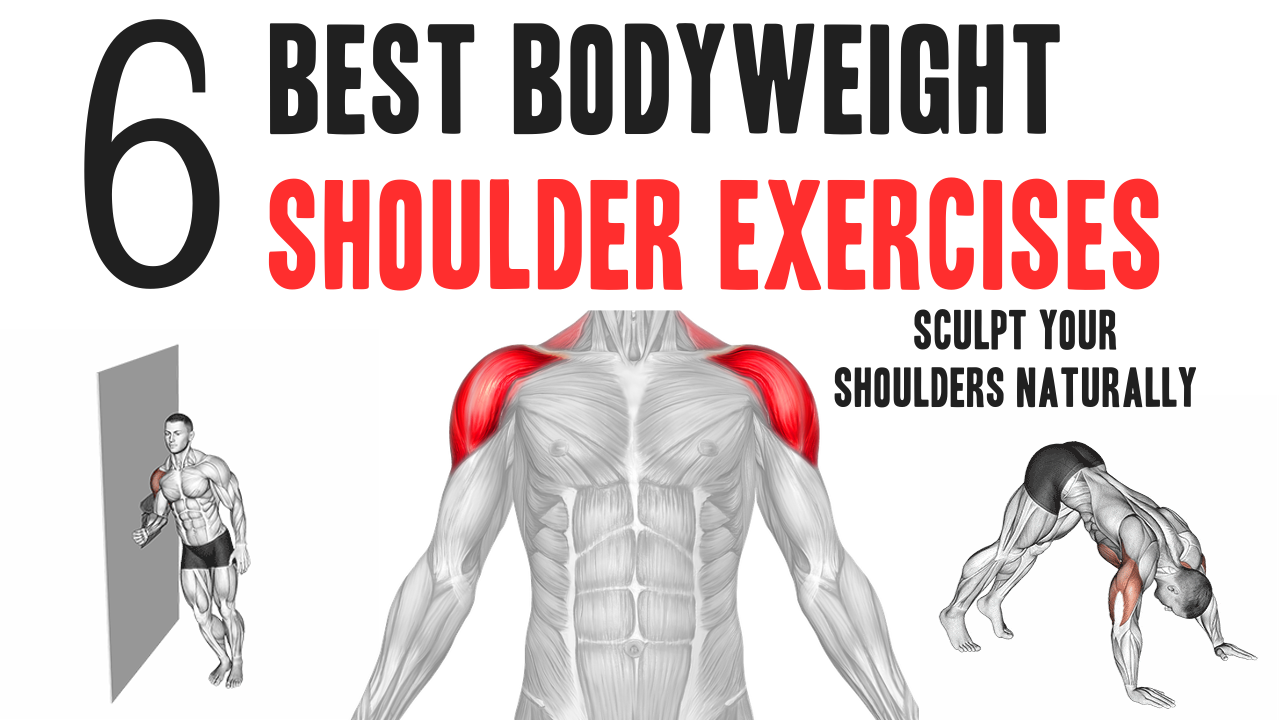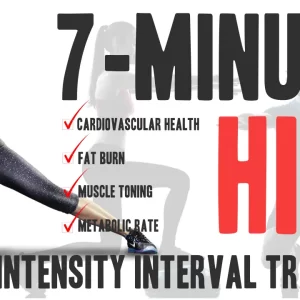Contents
Bodyweight shoulder exercises offer a convenient and effective way to sculpt your deltoids and improve shoulder stability. When it comes to building strong and defined shoulders, you don’t always need fancy gym equipment. These exercises not only require minimal equipment but also engage various muscle groups, leading to well-rounded upper body development. Let’s dive into six high-impact bodyweight shoulder exercises that can help you achieve impressive results without needing a single dumbbell or barbell.
Muscles Targeted:
- Deltoids (shoulder muscles)
- Triceps
- Upper chest
- Upper back muscles (scapular stabilizers)
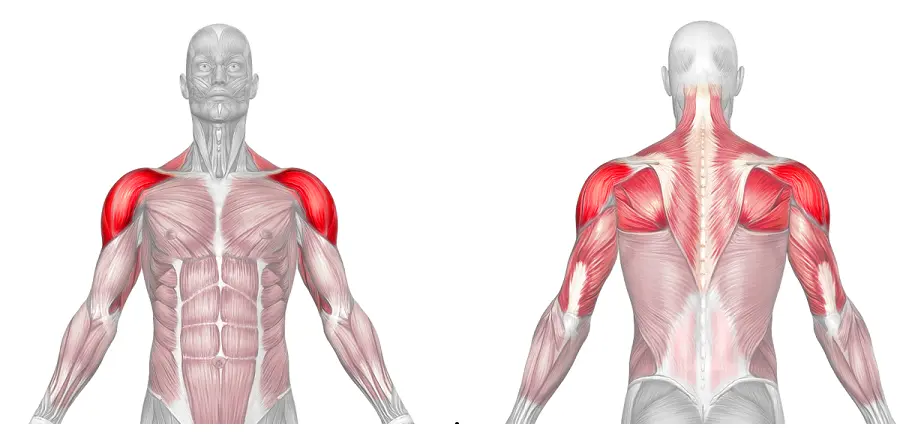
No-Equipment Bodyweight Shoulder Exercises
Warm Up: Always warm up your muscles before engaging in any workout. This could include some light cardio, dynamic stretches, or mobility exercises to prepare your body for the shoulder movements ahead.
1- Arm Circles:

Arm circles are a simple warm-up exercise that helps to improve shoulder mobility and flexibility. Stand with your arms extended straight out to your sides at shoulder level. Make small circular motions with your arms, gradually increasing the size of the circles. After a certain number of rotations, switch direction. Focus on controlled movements and maintaining proper form.
2- Wall Slides:
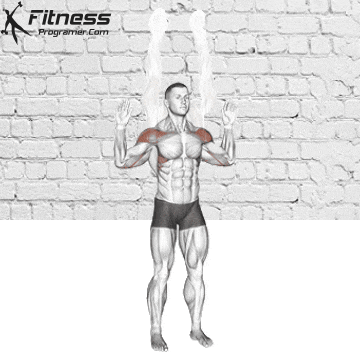
“Wall slides” typically refer to an exercise that involves sliding your arms up and down a wall in order to improve shoulder mobility and stability. It’s often used as a warm-up or mobility exercise, especially for individuals who are working on improving their overhead range of motion or addressing shoulder issues.
Instructions:
- Stand tall with your back against the wall. Your heels, buttocks, upper back, and back of the head should all be in contact with the wall. Maintain a natural arch in your lower back.
- Start with your arms bent at 90 degrees, with your elbows and wrists against the wall. Your palms should be facing forward.
- While keeping your back and arms in contact with the wall, gently slide your arms upward along the wall. Imagine you’re trying to touch the wall above your head. Keep your shoulders down and avoid shrugging them up.
- As you slide your arms up, you might find that your wrists or elbows begin to lose contact with the wall. That’s okay; go only as high as you can while maintaining proper form and contact points.
- Slowly slide your arms back down the wall to the starting position. Perform the sliding motion up and down the wall for a certain number of repetitions or for a designated period of time.
3- Lateral Raise with Towel on Wall:
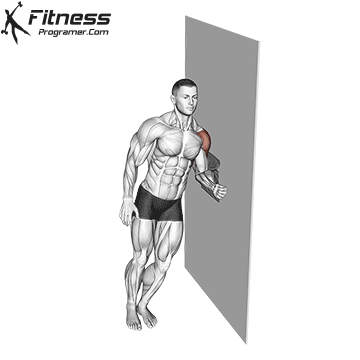
The “Lateral Raise with Towel on Wall” is a unique variation of the traditional lateral raise exercise. This exercise involves using a towel and a wall to create resistance while targeting the lateral deltoid muscles, which are the muscles on the sides of your shoulders. The added resistance from the towel and wall helps to engage the shoulder muscles more effectively, contributing to improved shoulder strength and definition.
Instructions:
- Begin with the arm holding the towel resting comfortably at your side, towel against your thigh.
- While keeping a slight bend in the elbow of the arm holding the towel, initiate the movement by slowly raising that arm out to the side at shoulder level.
- Focus on engaging your lateral deltoid muscles to lift your arm.
- Pause momentarily in the raised position, concentrating on the contraction in your lateral deltoid muscle.
- Slowly lower your arm back down to the starting position by your side. Maintain the towel tension throughout the lowering phase.
- Complete the desired number of repetitions on one side before switching to the other side.
4- Pike Push-up:
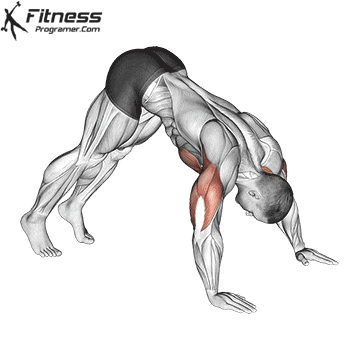
The Pike Push-Up is a variation of the traditional push-up exercise that primarily targets the shoulders, especially the anterior deltoids (front of the shoulders) and the triceps. It’s considered an effective bodyweight exercise for building upper body strength and stability.
Instructions:
- Begin in a high plank position with your hands placed slightly wider than shoulder-width apart and your feet close together. Your body should form a straight line from head to heels.
- Lift your hips up toward the ceiling while keeping your legs straight. Your body will resemble an upside-down “V” shape. Your head should be positioned between your arms, and your gaze should be towards your feet.
- Lower your upper body towards the ground by bending your elbows. Your head should move towards the ground between your hands. Keep your elbows pointing outward rather than flaring them out to the sides.
- Push through your palms and extend your elbows, raising your upper body back to the pike position.
- Lower your hips back down to the high plank position, returning to the starting position.
5- Wall Supported Handstand Push-up:

This advanced exercise helps build both shoulder and upper body strength. If you’re new to this exercise, start with bench pike push-ups (with your hips elevated) before attempting the full wall-supported handstand push-up.
Instructions:
- Start by facing a wall, about arm’s length away. Place your hands on the floor shoulder-width apart, fingers facing forward.
- Kick your feet up against the wall, slowly walking your feet up the wall until your body is almost vertical.
- Engage your core and maintain a straight line from your wrists to your hips and feet.
- Slowly lower your body by bending your elbows, bringing your head down towards the floor. Keep your elbows close to your body.
- Once your head comes close to the ground, push through your palms to extend your arms and return to the starting position.
6- Scapula Dips:
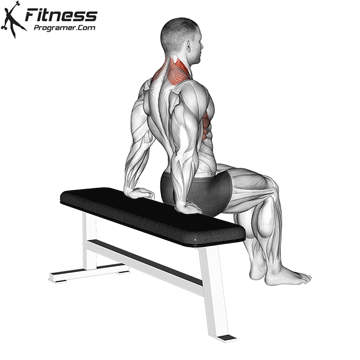
Scapula dips target the muscles surrounding your traps and shoulder blades. Sit on a bench or chair with your hands gripping the edges and fingers pointing forward. Slide your hips off the bench and bend your knees at 90 degrees. Lower your body slightly by steady your elbows while keeping your shoulder blades retracted. Push yourself back up, focusing on using your shoulder muscles to move your scapulae.
Proper Form and Technique for Bodyweight Shoulder Exercises
Before you start bodyweight shoulder exercises, there is one very important aspect that you need to master: proper form and technique.
1. Align Your Body:
Maintain a neutral spine throughout the exercises. Avoid arching your back excessively or rounding your shoulders. Engage your core to stabilize your body and protect your lower back.
2. Shoulder Blade Positioning:
Keep your shoulder blades down and back. This promotes stability and prevents unnecessary strain on the neck and upper traps.
3. Proper Hand Placement:
During pike push-ups and other exercises, place your hands slightly wider than shoulder-width apart. Distribute your weight evenly through your palms.
4. Controlled Movement:
Focus on controlled repetitions rather than rushing through the exercises. This minimizes the risk of injury and maximizes muscle engagement.
5. Full Range of Motion:
Perform exercises through their full range of motion while maintaining proper form. This ensures that you’re targeting all aspects of the shoulder muscles.
6. Breathing:
Inhale during the easier phase of the exercise and exhale during the more challenging phase. This helps stabilize your core and provide oxygen to your muscles.
7. Avoid Jerky Movements:
Sudden, jerky movements can strain your muscles and joints. Maintain a smooth, controlled motion. If you experience any discomfort or pain while performing the exercise, stop immediately and consult a fitness professional or healthcare provider.
Proper form and technique are the cornerstones of effective and safe bodyweight shoulder workouts. By paying attention to these details, you’re not only preventing injuries but also ensuring that you’re on the path to achieving your shoulder sculpting goals. Remember, it’s not about how quickly you complete the exercises, but how well you execute them.
Frequency, Progression, Sets and Reps:
- Frequency: Aim to include shoulder exercises in your routine 2-3 times per week.
- Sets and Reps: Start with 2-3 sets of 10-15 reps per exercise. Adjust based on your fitness level.
- Variation: Rotate between different exercises to target various shoulder muscles.
- Progression: As you get stronger, increase reps, perform more challenging variations, or use longer holds.
- Rest: Allow 45-60 seconds of rest between sets to recover.
The Bottom Line
Strengthening and shaping your shoulders also includes eating a balanced diet and managing your body composition. While they might not provide the same level of resistance as heavy weights, bodyweight exercises offer a variety of movements that effectively target your shoulder muscles and contribute to their sculpting. While bodyweight exercises can be sufficient for many individuals, you can always add external resistance (like resistance bands or dumbbells) to increase the challenge when necessary. As a result, the combination of proper nutrition and effective exercise can help you achieve the shoulder aesthetics you want.
Other topics related to Shoulder Development

